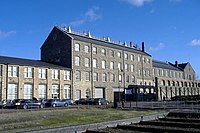Historic England
The Historic Buildings and Monuments Commission for England, generally known as Historic England, is an executive non-departmental public body of the British Government (a "quango") sponsored by the Department for Culture, Media and Sport. It is tasked with protecting the historical environment of England by preserving and listing historic buildings, ancient monuments and advising central and local government. The equivalent state bodies elsewhere in the kingdom are:
- Cadw (Wales)
- Historic Scotland
- The Northern Ireland Environment Agency
The body was officially created by the National Heritage Act 1983 and assumed functions for maintaining ancient monuments had previously been undertaken by part of the Department of the Environment which was the successor to the Ministry of Works. The 1983 Act also dissolved the bodies that had hitherto provided independent advice — the Ancient Monuments Board for England and the Historic Buildings Council for England and incorporated these functions in the new body. Another advisory body, the Royal Commission on the Historical Monuments of England was not merged with the new Commission until 1 April 1999.[1]
Division
From foundation until April 2015, the Historic Buildings and Monuments Commission for England operated under the working name of 'English Heritage'.[2]
In 2013 though the Government decided to divide English Heritage in two; the Historic Buildings and Monuments Commission for England would remain in the state sector, under the working name 'Historic England', fulfilling statutory functions; 'English Heritage' though would be floated off as a charity (the English Heritage Trust)[3], charged with the protection of the National Heritage Collection.[4]
Archives
Historic England inherits the Historic England Archive from the old English Heritage, and projects linked to the archive such as Britain from Above which saw the archive work with RCAHMW and RCAHMS to digitise, catalogue and put online 96,000 of the oldest Aerofilms images. The archive also holds various nationally important collections and the results of older projects such as the work of the National Buildings Record, later absorbed by the Royal Commission on the Historical Monuments of England and the 'Images of England' project which set out to create a freely accessible online database of the 370,000 listed properties in England at a snapshot in time at the turn of the millennium.
The state body has a similar remit to, and complements the work of, Natural England which aims to protect the natural environment.
Remit

Historic England inherits English Heritage's position as the government's statutory adviser and a statutory consultee on all aspects of the historic environment and its heritage assets.[5] This includes archaeology on land and under water, historic buildings sites and areas, designated landscapes and the historic elements of the wider landscape.[6] It monitors and reports on the state of England's heritage and publishes the annual the Heritage at Risk survey which is one of the UK Government's Official statistics. It is tasked to secure the preservation and enhancement of the man-made heritage of England for the benefit of future generations.[6]
Its remit involves:
- Caring for nationally important archive collections of photographs, drawings and other records which document the historic environment of England and date from the eighteenth century onwards.
- Giving grants national and local organisations for the conservation of historic buildings, monuments and landscapes. In 2013/14 over £13 million worth of grants were made to support heritage buildings.[7]
- Advising central government on which heritage assets are nationally important and should be protected by designation (i.e. listing, scheduling etc.).[8][9]
- Administering and maintaining the register of England's listed buildings, scheduled monuments, registered battlefields, conservation areas and protected parks and gardens.[10] This is published as an online resource as 'The National Heritage List for England'.
- Advising local authorities on managing changes to the most important parts of heritage.
- Providing expertise through advice, training and guidance to improve the standards and skills of people working in heritage, practical conservation and access to resources. In 2009–2010 it trained around 200 professionals working in local authorities and the wider sector.[7]
- Consulting and collaborating with other heritage bodies, local and national planning organisations e.g. the preparation of Planning Policy statement for the Historic Environment (PPS5)[11]
- Commissioning and conducting archaeological research, including the publication of 'Heritage Counts' and ‘Heritage at Risk’ on behalf of the heritage sector which are the annual research surveys into the state of heritage assets within England.
It is not responsible for approving alterations to listed buildings. The management of listed buildings is the responsibility of local planning authorities and the Department for Communities and Local Government.[11]
It also owns the National Heritage Collection of nationally important historic sites, currently in public care. However they do not run these sites as this function is instead carried out by the English Heritage Trust under licence until 2023.[12]
See also
Outside Links
- Historic England
- The Historic England Archive
- Britain from Above: Aerofilms, aerial photographs from 1919-1953
- Images of England
- Heritage Explorer: Education site
References
- ↑ Conservation Bulletin, Issue 35, April 1999
- ↑ "Historic England's Role". Historic England. http://www.historicengland.org.uk/about/what-we-do/historic-englands-role/. Retrieved 6 April 2015.
- ↑ [ The English Heritage Trust] - Registered Charity no. 1140351 at the Charity Commission
- ↑ New Era for England's Heritage - English Heritage, 6 April 2015]
- ↑ "Historic Environment". http://www.culture.gov.uk/what_we_do/historic_environment/default.aspx. Retrieved 16 May 2011.
- ↑ 6.0 6.1 "Funding of the Arts and Heritage". http://www.publications.parliament.uk/pa/cm201011/cmselect/cmcumeds/writev/464/074.htm. Retrieved 16 May 2011.
- ↑ 7.0 7.1 "English Heritage Annual Report and Accounts". English Heritage. https://content.historicengland.org.uk/images-books/publications/eh-ann-rep-accounts-13-14/eh-ann-rep-accounts-2013-14.pdf/. Retrieved 6 April 2015.
- ↑ "Ancient Monuments and Archaeological Areas Act 1979". http://www.legislation.gov.uk/ukpga/1979/46/contents. Retrieved 16 May 2011.
- ↑ "National Heritage Act 1983, Historic Buildings and Monuments Commission for England". http://www.legislation.gov.uk/ukpga/1983/47/crossheading/historic-buildings-and-monuments-commission-for-england. Retrieved 16 May 2011.
- ↑ "Planning (Listed Buildings and Conservation Areas) Act 1990". http://www.legislation.gov.uk/ukpga/1990/9/contents. Retrieved 16 May 2011.
- ↑ 11.0 11.1 "Planning Policy Statement 5: Planning for the Historic Environment". http://www.communities.gov.uk/publications/planningandbuilding/pps5. Retrieved 16 May 2011.
- ↑ "Historic England and the English Heritage Trust". Historic England. http://www.historicengland.org.uk/about/what-we-do/historic-england-and-english-heritage/. Retrieved 6 April 2015.